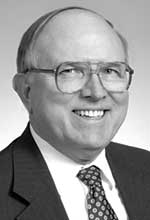2005 AAE Distinguished Engineering Alumnus

Paul M. Bevilaqua
Chief Engineer, Advanced Development Projects
Lockheed Martin Skunk Works
MSAAE ’68, PhD ’73
For his pioneering contributions to aerospace design and to the defense of our nation, and for his service to Purdue University, the College of Engineering is proud to present the Distinguished Engineering Alumnus Award to Paul M. Bevilaqua.
Technology Changes, Science Lasts
“When I was at Purdue, we used punch cards and drawing tables, and airplanes looked like 707s—all of that’s obsolete now,” says Paul Bevilaqua. “Purdue taught me that technology changes, but science lasts. As an undergraduate, I learned how the pieces are moved, and at Purdue I learned how to play chess.”
Bevilaqua studied at Notre Dame as an undergraduate before enrolling in Purdue’s School of Aeronautics and Astronautics as a graduate student. He graduated from Purdue with a PhD in 1973 and then served as a captain in the U.S. Air Force and Deputy Director of the Energy Conversion Laboratory at Wright-Patterson Air Force Base in Ohio. From 1975 to 1985, he was Manager of Advanced Programs at Rockwell International’s Navy Aircraft Plant in Columbus, Ohio. Then Bevilaqua joined the Lockheed Martin Skunk Works in Palmdale, California, as Chief Engineer of Advanced Development Projects. At the Skunk Works, Bevilaqua began work on concepts for a supersonic Vertical Take Off and Landing (VTOL) Aircraft—a jet airplane that can hover like a helicopter.
“The essential challenge is to hover well,” Bevilaqua says. “The difficulty with trying to pack a helicopter rotor into an airplane has been that you can’t make the rotor small enough and get enough thrust out of it to hover.”
Britain’s Harrier jet, for example—the first production airplane to land and take off vertically—is designed so that the pilot actually sits in the air inlet of a fan so large that the plane is unable to achieve supersonic flight.
“We needed to find some way to get increased air flow and reduced disk loading and still be able to achieve supersonic flight,” Bevilaqua says.
One From Column A, One From Column B, One From Column C
The concept was to take the one big fan in the Harrier and break it into two little fans, and then find a new method of powering the fans. So Bevilaqua drew three columns in a computer that listed all the ways that he could extract power from the hot, high-pressure gas blasting from the nozzle—spin a turbine, run a generator, charge it with ions and run it through a magnet—another column that listed all the ways he could transfer power from the back of the airplane to the front—through a wire, beam it with a laser, run a shaft—and all the ways in which he could turn power into lift—with a rocket, with a propeller, with a cannon. “I took these lists and forced associations,” he says. “I took one from column A, one from column B, one from column C, and then tried to invent a system that used those three mechanisms.”
Frustrated, Bevilaqua found that there was no better way than the tried-and-true approach of the turbine engine and fan mechanism, so he realized he would have to redesign the turbine if he was to create an aircraft that could hover like a hummingbird.
“I suddenly thought of a way to switch the cycle of a jet engine from a thrust cycle, like on a conventional jet engine, to a shaft cycle, like the turbines on a ship or a helicopter,” Bevilaqua says. “It took eight months of brainstorming to program the computer in my head, and ten seconds to come up with the idea. I guess it was kind of an ‘aha!’ moment.”
Winning the Joint Strike Fighter Competition
Lockheed Martin patented Bevilaqua’s Lift Fan Propulsion System under his name in 1993.
The development of the innovative, light-weight, supersonic VTOL prototype garnered Bevilaqua a prestigious “Engineer of the Year Award” from Design News and an American Institute of Aeronautics and Astronautics Aircraft Design Award. He has won numerous industry citations, among them the Lockheed Martin AeroStar and NOVA awards, a U.S. Air Force Scientific Achievement Award, and the Collier Trophy for his propulsion system. In 2002 he was honored with an Outstanding Aerospace Engineer Award from Purdue.
That same year, Lockheed Martin won the Joint Strike Fighter competition, the largest military aircraft contract ever awarded. According to industry insiders, Bevilaqua’s VTOL design was a key factor in the military’s decision.
Serving Purdue
In addition to his professional achievements, Bevilaqua has served as a member of the School of Aeronautics and Astronautics’ Industrial Advisory Council.
“I was fortunate in being invited to serve on the advisory committee,” he says, “and staying in the Midwest after I graduated, I was able to keep up my links with the University, continuing to learn—that’s another very important thing that I learned at Purdue: that you can’t learn everything you need in school and then throw your books away and be successful in your career.”
Career Highlights
| 2004 | Engineer of the Year, Design News |
|---|---|
| 2004 | Paul E. Haueter Award, AHS International |
| 2002 | Aircraft Design Award, AIAA |
| 2002 | Outstanding Aerospace Engineer Award, Purdue |
| 1993 | Lift Fan Propulsion System patented |
| 1991— | Chief Engineer, Advanced Development Projects, Lockheed Martin Skunk Works, Palmdale, Calif. |
| 1985 | Chief Aeronautical Scientist, Lockheed Advanced Aeronautics Company, Burbank, Calif. |
| 1975 | Manager of Advanced Programs at Rockwell International's Navy Aircraft Plant, Columbus, Ohio |
| 1971 | Captain, U.S. Air Force and Deputy Director, Energy Conservation Laboratory, Wright Patterson AFB, Ohio |
BSAE ’67, University of Notre Dame
MSAAE ’68, PhD ’73, Purdue University
